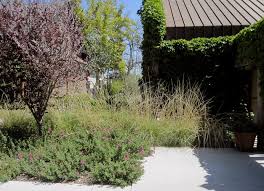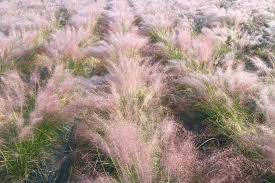Muhlenbergia Grass, also known as Muhly Grass, is a beautiful and popular type of ornamental grass. It adds a graceful touch to gardens and landscapes with its feathery plumes and vibrant colors. This type of grass is named after a botanist named Gotthilf Heinrich Ernst Muhlenberg, who was passionate about studying plants.
Muhlenbergia Grass is known for its fine, slender leaves that form dense clumps. These clumps can vary in size depending on the specific species and variety of Muhlenbergia. One of its most attractive features is its flowering plumes that emerge in late summer and fall. These plumes can range in color from soft pink and purple to white, creating a striking contrast against the green foliage.
One of the great things about Muhlenbergia Grass is that it is relatively easy to care for. It is drought-tolerant once established, which means it can handle dry conditions without needing too much water. This makes it a great choice for landscapes where water conservation is important. Planting Muhlenbergia in well-draining soil and providing it with plenty of sunlight will help it thrive.
Muhlenbergia Grass can be used in various ways in your garden or landscape. It works well as a border plant, adding a touch of elegance to pathways or edges of flower beds. It can also be planted in groups to create a visually appealing mass of swaying grasses. Additionally, Muhlenbergia Grass can be used as a focal point in a garden, drawing attention with its distinctive texture and color.
In addition, Muhlenbergia Grass is a charming and easy-to-care-for ornamental grass that can enhance the beauty of any garden or landscape. With its graceful appearance, drought tolerance, and versatility, it’s no wonder that Muhlenbergia Grass has become a favorite among gardeners and landscapers alike.
Read Also: Everything You Need To Know About Pallet of Grass
Growing and Care Guide of Muhlenbergia Grass

Growing and caring for Muhlenbergia Grass, also known as Muhly Grass, is quite straightforward and can bring a touch of beauty to your garden. Here’s a simple guide to help you get started:
1. Location: Choose a sunny spot in your garden for planting Muhlenbergia Grass. It thrives in full sunlight and will produce more vibrant plumes in bright light.
2. Soil: Muhlenbergia Grass prefers well-draining soil. Make sure the soil is not too compacted, as good drainage is essential for its health.
3. Planting: Plant Muhlenbergia Grass in the spring or early fall. Dig a hole slightly larger than the root ball and place the plant at the same level it was in its nursery container. Fill the hole with soil and gently tamp it down.
4. Watering: Initially, water the grass regularly to help it establish its root system. Once established, Muhlenbergia is quite drought-tolerant and doesn’t need frequent watering. Water deeply when you do water, allowing the soil to dry out between waterings.
5. Pruning: In late winter or early spring, trim back the old growth to about 6 inches above the ground. This will encourage new growth and maintain a neat appearance.
6. Fertilizing: Muhlenbergia Grass doesn’t require a lot of fertilizer. You can apply a balanced, slow-release fertilizer in the spring, but avoid over-fertilizing as it can lead to excessive foliage growth and less prominent plumes.
7. Mulching: Adding a layer of mulch around the base of the plant can help retain moisture and suppress weeds. Keep the mulch a few inches away from the plant’s crown to prevent rot.
8. Pests and Diseases: Muhlenbergia Grass is generally resistant to pests and diseases. However, keeping the area around the plant clean and well-maintained can help prevent any potential issues.
9. Division: Over time, Muhlenbergia Grass can become crowded. To rejuvenate the plant and maintain its vigor, you can divide it every few years in the spring. Dig up the clump, separate the sections, and replant them in suitable locations.
10. Winter Care: Most varieties of Muhlenbergia Grass are hardy, but in colder climates, it’s a good idea to leave the foliage standing through the winter. The dried plumes can provide some visual interest in the winter landscape.
By following these simple steps, you can enjoy the beauty of Muhlenbergia Grass in your garden while keeping its care manageable. Remember that each plant might have specific needs, so it’s a good idea to consult local gardening resources or professionals for advice tailored to your region.
Muhlenbergia Capillaris Grass
Muhlenbergia Capillaris, also known as Pink Muhly Grass, is a type of ornamental grass that adds a lovely touch of color and texture to gardens and landscapes. Its feathery pink plumes create a stunning display, making it a favorite among garden enthusiasts.
Pink Muhly Grass is known for its delicate appearance. The slender leaves form attractive clumps, and in late summer and fall, the plant transforms with the emergence of its iconic pink plumes. These plumes dance in the breeze and create a soft, cloud-like effect that adds a unique charm to any outdoor space.
When planting Muhlenbergia Capillaris, choose a sunny spot in your garden. This grass loves sunlight and will thrive in areas with plenty of direct sunlight. The soil should be well-draining to prevent water from pooling around the roots.
Caring for Pink Muhly Grass is relatively easy. Water the plant regularly during its initial growth period to help establish its root system. Once established, it becomes more drought-tolerant, needing less frequent watering. Adding a layer of mulch around the base of the plant can help retain moisture and keep weeds at bay.
In late winter or early spring, trim back the old growth to about 6 inches above the ground. This pruning helps the plant to produce fresh growth and maintain a neat appearance. If the clump becomes too large over time, you can divide it by carefully separating sections and replanting them.
One of the remarkable features of Muhlenbergia Capillaris is its ability to attract attention. Planted in groups, it can create a breathtaking mass of pink plumes that becomes the focal point of your garden. Its vibrant color and unique texture make it an ideal choice for borders, pathways, or even as a standalone statement plant.
In colder climates, leaving the dried plumes standing through the winter can provide visual interest, and you can trim them back in early spring before new growth begins.
Furthermore, Muhlenbergia Capillaris, or Pink Muhly Grass, is a stunning and easy-to-care-for ornamental grass that can elevate the beauty of any garden or landscape. With its elegant appearance, resilience, and eye-catching pink plumes, it’s no wonder that Pink Muhly Grass has captured the hearts of gardeners and nature lovers.
Read Also: Bermuda Sod Grass: All You Need To Know About
Benefits of Muhlenbergia Capillaris Grass

Here are seven good benefits of Muhlenbergia Capillaris, or Pink Muhly Grass:
1. Aesthetic Appeal: The most obvious benefit of Pink Muhly Grass is its stunning visual appeal. The delicate pink plumes create a soft and ethereal atmosphere in gardens and landscapes, adding a touch of elegance and charm.
2. Low Maintenance: Pink Muhly Grass is relatively low-maintenance once established. It requires minimal pruning and is drought-tolerant, making it suitable for both experienced and novice gardeners.
3. Versatility: This ornamental grass can be used in various landscaping scenarios. It works well as a border plant, in mass plantings, or even as a standalone specimen to create eye-catching focal points.
4. Wildlife Habitat: The feathery plumes of Pink Muhly Grass can provide shelter and nesting material for small birds and insects. It contributes to creating a mini wildlife habitat in your garden.
5. Erosion Control: The dense clumps of roots that Pink Muhly Grass forms help stabilize soil and prevent erosion, making it a useful addition to slopes and areas prone to erosion.
6. Seasonal Interest: The pink plumes of the grass provide late-season interest, extending the beauty of your landscape well into the fall when many other plants have faded.
7. Natural Screening: Pink Muhly Grass can serve as a natural and attractive way to create screens or partitions in your outdoor space, offering a degree of privacy without the need for traditional barriers.
These benefits highlight the value that Muhlenbergia Capillaris, or Pink Muhly Grass, can bring to your garden or landscape, enhancing both its aesthetics and functionality.
Read Also: Everything You Need to Know About Recycling Labels
